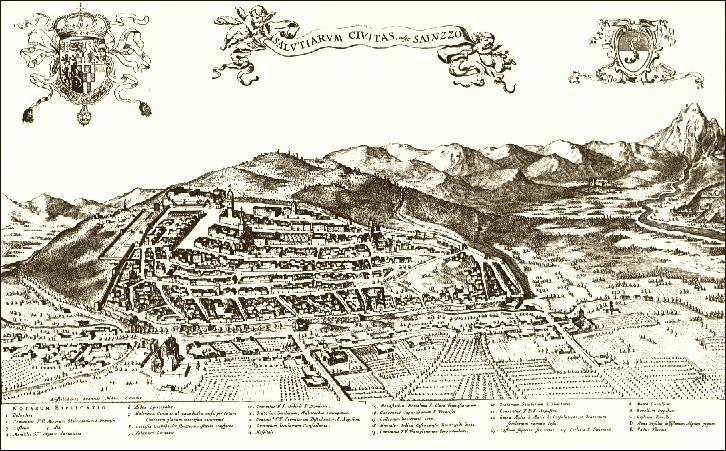The history of the city of Saluzzo is inextricably linked to that of the homonymous Marquisate which arose during the wars that followed the dissolution of the vast domain of the powerful Arduinica family.
After having been a “curtis” under the direct control of the Marquis of Turin, Olderico Manfredi, from about 1090 it became a fief of the Marquis Bonifacio del Vasto, belonging to the Aleramic lineage.
The history of the marquisate of Saluzzo began with Manfredo (d. 1175), son of Bonifacio del Vasto and heir to a portion of his father’s vast domains situated between the Po, the Alps and the Stura. It was Manfredo who chose Saluzzo as the organizing center of the area, although it was his son Manfredo II (1175-1215) who was the first to assume the title of Marquis of Saluzzo.
With the progressive weakening of the local lords, the authority of the marquis gradually extended over a unified territory: at the end of the 1200s the Marquisate of Saluzzo was a fairly compact set of territories including the Stura, Grana, Maira and Po valleys, as well as the strip of plain that from the foot of the Cottian Alps wedged in the middle of the Savoy dominions up to Carmagnola.
After the initial phase of consolidation, the small state – strong in its natural defenses, supported by the alpine valleys – managed to survive and save its independence by weaving alliances with the surrounding powers, trying to take advantage of the endless disputes between large and rich communes, (such as Asti), from neighboring and hostile seigniories (Savoy, Monferrato, Acaja) and inconvenient foreign invaders (Angevins).
For centuries this small but brilliant feudal state managed to be the hinge between Piedmont, France and Liguria, assimilating the style and culture of the Gothic beyond the Alps but also opening up to the breath of Humanism and the Italian Renaissance.
Towards the middle of the 1300’s, pressed by the growing threat of the Savoy family, the Marquises had to draw closer and closer to the Dauphiné, obtaining a not disinterested protection, and then to the Crown of France, in whose orbit they fatally gravitated.
The period of maximum splendor of the Marquisate is to be placed between 1400 and the first decades of 1500, under the successive governments of Ludovico I and Ludovico II. The economic expansion and a growing prosperity, guaranteed by a long period of internal and external peace, favored the flourishing of arts and letters.
However, in the last years of Ludovico II and under his sons and successors, the Marquisate of Saluzzo was involved in the French-Spanish duel for the Visconti and Angevin inheritance and then in the fierce struggle between Charles V and Francis I for European hegemony.
Thus, in the first decades of the 1500s, the Marquisate, having lost Cuneo and the Stura valley, which came under the dominion of the Savoy family, and other lands in the hands of the princes of Achaia, was reduced to the valleys of the Po, Varaita, Maira, Grana and Bronda.
In a context strongly tried by wars, looting and famine, inside the marquisate worsened the situation the disputes that broke out between the brothers Francesco, Giovanni Ludovico and Michele Antonio, sons of Ludovico II. The outcome of this internal weakness paved the way for Francis I of France who increasingly exerted his influence on the marquisate. In 1548, tired of the continuous struggles and the uncertainty that resulted, the communes of the marquisate decided to invite Henry II King of France to submit the marquisate to his rule, which the following year was reunited with the Dauphiné for a period of about forty years.
In September 1588 Carlo Emanuele I of Savoy, after some unsuccessful attempts to reconquer the marquisate to France, occupied the lands of the marquisate. In the following Peace of Vervins (1598) it was agreed that the Duke of Savoy continued to occupy those lands until the settlement of the question, which was referred to the arbitration of the pontiff. The question was then definitively defined by the Peace of Lyon (1601), with which the Duke of Savoy, by ceding Bresse, Bugey, the village of Gex and Valromey to France, obtained in exchange the marquisate of Saluzzo.




